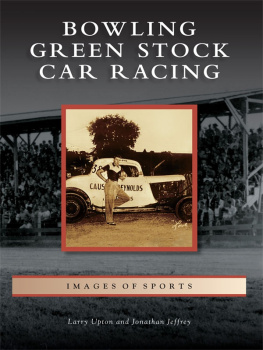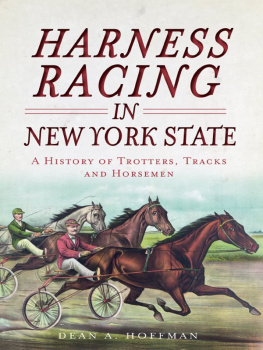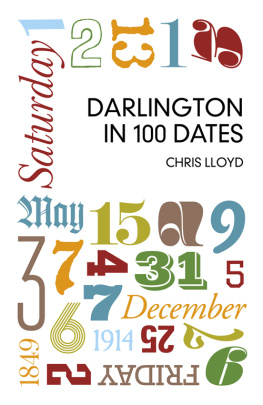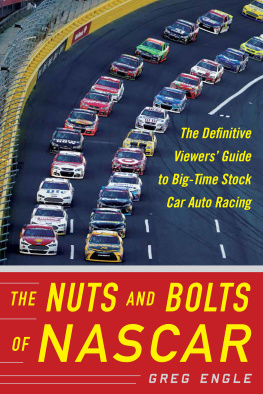Copyright 2013 by Cathy Elliott
ISBN 978-1-6251-7171-9
Published by Arcadia Publishing
Charleston, South Carolina
Printed in the United States of America
Library of Congress Control Number: 2012949183
For all general information, please contact Arcadia Publishing:
Telephone 843-853-2070
Fax 843-853-0044
E-mail
For customer service and orders:
Toll-Free 1-888-313-2665
Visit us on the Internet at www.arcadiapublishing.com
NASCAR and NASCAR Library Collection are registered trademarks of the National Association for Stock Car Auto Racing, Inc.
For Darlington Raceway, a great lady who changed
my life by making a believer out of me.
CONTENTS
FOREWORD
Every young boy remembers that one special girl, that first love. The one that stole his heart and forever left a mark on his soul. It cannot be explained, but every man understands what I am saying. For me, that special she is an unusual ladya Lady in Blacka piece of asphalt lying in the coastal plain of rural South Carolina.
As a child in the early 1970s, I sat in my bedroom, a mere two miles from Darlington Raceway, trying to guess who was turning laps on that famous piece of special asphalt. Was it David Pearson? Maybe it was Cale Yarborough, or maybe it was the king himself, Richard Petty. I never really knew, but the imagination of a six-year-old created his own race, right there in that bedroom. It was the beginning of a 40-year love affair that to this day still burns brightly.
Just days before my sixth birthday, my dad, Terry, took me to my first Southern 500. This mysterious lady had also placed him under her spell, many years earlier.
My mom, Zena, made a bag of sandwiches for us. What a thrill: no more imagination. The sounds, the smells, and the roar of the engines were incredible. This was the real deal. I was really there at The Lady in Black. There was Pearson, and there was Cale, and yes, even King Richard was on the race track. From that moment, I was in love.
That day began a decades-long tradition that ended, ironically, when I went to work at Darlington Raceway in 1990. My dad continued to make his annual visits to the track, while I worked.
I still find myself in awe of this incredible first love. I share my daily life with her. She has changed over the years. She has added new asphalt, new grandstands, and new amenities, but her spell is still as captivating today as it was for that six-year-old boy all those years ago. I cannot imagine working anywhere else in this big world.
My dad passed away in 2002. My son, Stephen, now makes his annual visit to the The Lady in Black. The cycle is complete. That is Darlington.
Terry M. Josey
Vice president and general manager of Darlington Raceway
ACKNOWLEDGMENTS
This project began with one goal: to present Darlington Raceway as I have come to know her. Darlington Raceway is one of the most historical and vital links in the NASCAR chain, but she is more than just a race track that comes alive once a year. Darlington is an integral member of her community, part of its very identity. Everyone in town has at least one story about the track. Most of them have literally grown up in her shadow. Darlington is family.
I went to the community members for help, and they responded, offering bits and pieces of history from their personal collections and, as a bonus, sharing lots of stories about their beloved Lady in Black.
First and foremost, I would like to thank the staff of Darlington Raceway, particularly Chris Browning, Mac Josey, Dennis Worden, Sarah Hill, and Lee Taylor. They not only supported the project in spirit, but also opened their closets, their filing cabinets, and their sometimes-dusty cardboard boxes to me, even letting me snatch photographs off the walland climb one special wallwhen the need arose.
Thanks also to Lisa Chalian-Rock for her stellar graphic skills; to Hunter Thomas for knowing you should never delete a photograph; and to Arcadia Publishing and Maggie Bullwinkel for trusting me with this special subject and for bearing with me throughout the process.
INTRODUCTION
Decades before Kevin Costners supernatural baseball diamond rose from an Iowa cornfield in the movie Field of Dreams, the same story was played out in earnest in Darlington, South Carolina.
The Darlington Raceway deal was originally struck over a Saturday night card game in the towns textile mill. Local legend says that when real estate developer Harold Brasington suggested to his friend Sherman Ramsey during a friendly game of poker that they build a race track on a largely unused piece of land just outside of the city limits, Ramsey, who owned the land, replied, Sure. Now deal the cards.
Almost one year to the day later, Darlington Raceway was open for business, hosting the inaugural Southern 500 on September 6, 1950. The day would go down in history as the beginning of a new era in motorsports, paving the way for todays high-speed chases and white-knuckle action.
Upon completion, the track itself looked a bit different than Brasington had originally envisioned it. Ramsey, an avid sportsman who loved to fish, would not allow his friend to disturb a small minnow pond located on the property, just outside of the area where the track was to be built. To save the pond, Brasington had to tighten the turns at the west end of the raceway, pinching it in on one corner and giving Darlington her trademark egg shape.
Darlington Raceway possesses that indefinable quality that is recognizable but difficult to describe. Some call it the it factor, but in this case, that term definitely does not apply. Prior to 1950, no one had ever seen anything like this oddly shaped speedway before. She was a complete mystery, and in the years since, no driver has ever been completely successful in figuring her out.
The track is so deeply ingrained not only in the business of stock car racing but also in its very heart and soul that Darlington Raceway is the only speedway always referred to as she rather than it.
This is a place where history has been made time and again, a place where men have become legends. It is almost easier to imagine Christmas without Santa than to picture NASCAR without Darlington. She has been on the receiving end of some criticism as newer, shinier, chrome-and-glass racing facilities caught the imagination of the public. But Darlington has never been one to back away from a challenge; she is home and knows there is no place like it.
She has been welcoming, but if some sassy NASCAR upstart needed to be taught a lesson in race track respect, she was more than willing to oblige. She has aged gracefully but has shown a canny knack for realizing that even the most legendary woman in racing can benefit from a little cosmetic help now and then. Darlington has character and personality: she is cool.
She is also a tough customer, from the abrasive racing surface to the concrete retaining wall. Drivers claim it is practically impossible to find the perfect setup for driving at Darlington because of the tracks irregular configuration, and many a driver has brushed against the wall while making his way around the track.
In fact, popular opinion holds that if you have not earned your Darlington stripemaking contact with the wall, resulting in a long black mark on both the wall and the right side of the caryou have not fully arrived in racing. Over the years, that wall has been swiped, and striped, by NASCARs biggest names, who have colorfully and literally left their marks on Darlington Raceway.










